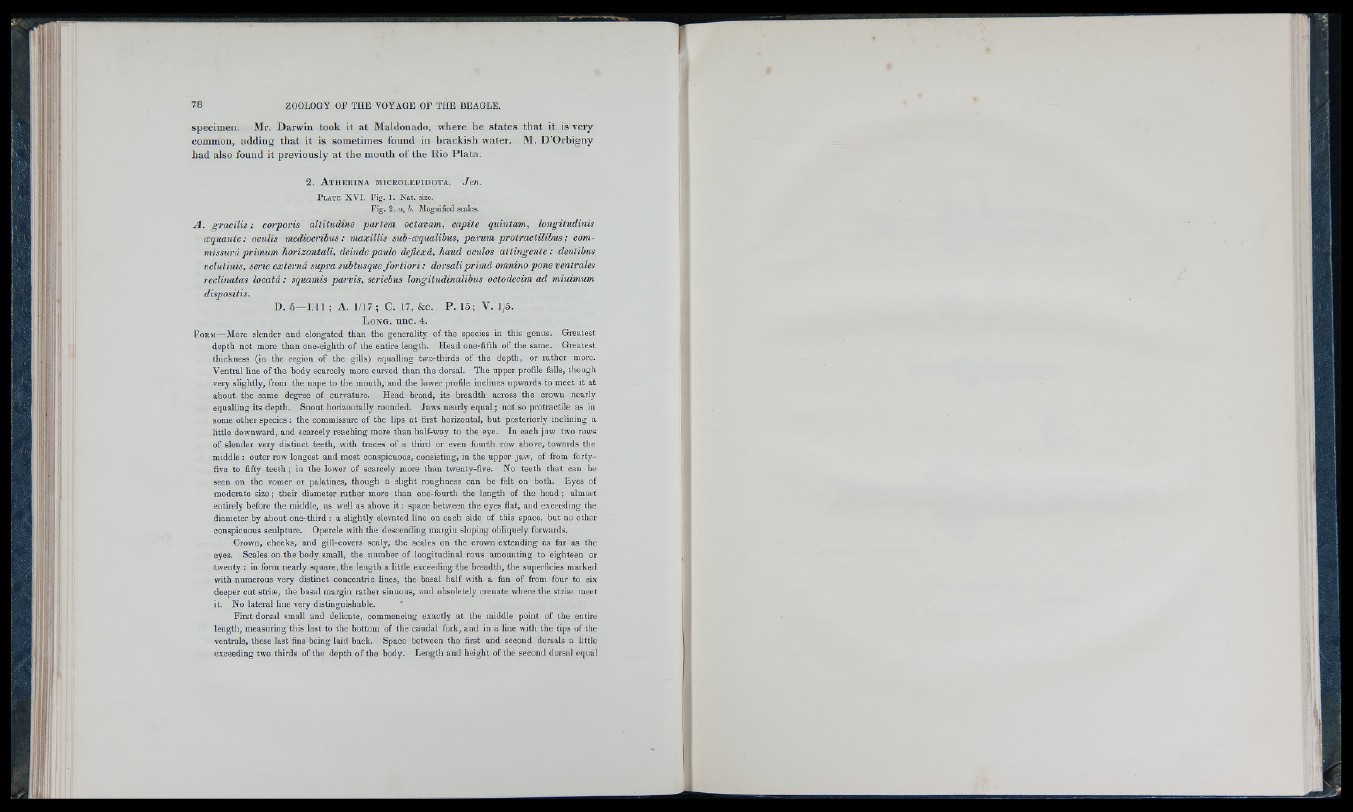
specimen. Mr. Darwin took it at Maldonado, where he states that it is very
common, adding that it is sometimes found in brackish water. M. D ’Orbigny
had also found it previously at the mouth of the Rio Plata.
2 . A t h e r in a m ic r o l e p id o t a . Jen.
P l a t e X V I. Fig. 1. Nat. size.
Fig. 2. a, h. Magnified scales.
A . gracilis; corporis altitudine partem octavam, capite quintam, longitudinis
oequanle : oculis mediocribus : maxillis sxib-iPqualibus, parum protractilibus ; com-
missuru primum horizontali, delude paulo dejlexâ, haud oculos attingente : dentibus
velutinis, serie externa supra sxiblusque fortiori : dorsaliprirnâ omnino pone ventrales
recUnatas locatâ : squamis parvis, seriebus longiludiyialibus octodeciyn ad yyiiniynum
dispositis.
D. 5—1/11 ; A. 1/17; C. 17, &c. P. 15; V. 1/5.
L o n g . u n c . 4.
F o r m — 'More slender and elongated than the generality of the species in this genus. Greatest
depth not more than one-eighth of the entire length. H ead one-fifth o f the same. Greatest
thickness (in the region of the gills) equalling two-thirds of the depth, or rather more.
V entral line of the body scarcely more curved than the dorsal. The upper profile fails, though
very slightly, from the nape to the m outh, and the lower profile inclines upw ards to meet it at
about the same degree o f curvature. Head broad, its breadth across the crown nearly
equalling its depth. Snout horizontally rounded. Jaw s nearly equ al; not so protractile as in
some other species : the commissure of the lips a t first horizontal, but posteriorly inclining a
little downward, and scarcely reaching more than half-way to the eye. In each jaw two rows
of slender very distinct teeth, with traces of a third or even fourth row above, towards the
middle : outer row longest and most conspicuous, consisting, in the upper jaw , of from forty-
five to fifty teeth ; in the lower o f scarcely more than twenty-five. No teeth that can be
seen on the vomer or palatines, though a slight roughness can be felt on both. Eyes of
moderate size ; their diameter rather more than one-fourth the length of the head ; almo.«t
entirely before the middle, as well as above it: space between the eyes flat, and exceeding the
diameter by about one-third : a slightly elevated line on each side of this space, but no other
conspicuous sculpture. Opercle with the descending margin sloping obliquely forwards.
Crown, cheeks, and gill-covers scaly, the scales on the crown extending as far as the
eyes. Scales on the body small, the num ber of longitudinal rows amounting to eighteen or
twenty : in form nearly square, the length a little exceeding the breadth, the superficies marked
with numerous very distinct concentric lines, the basal half with a fan of from four to six
deeper cut striæ , the basal m argin rather sinuous, and obsoletely crenate where the striæ meet
it. N o lateral line very distinguishable.
F irst dorsal small and delicate, commencing exactly at the middle point of the entire
length, measuring this last to the bottom o f the caudal fork, and in a line with the tips of the
ventrals, these last fins being laid back. Space between the first and second dorsals a little
exceeding two thirds of the depth o f the body. Length and height of the second dorsal equal